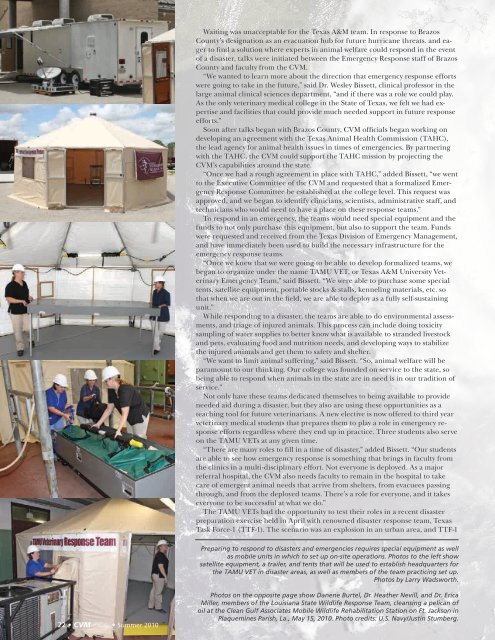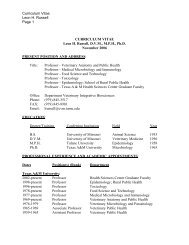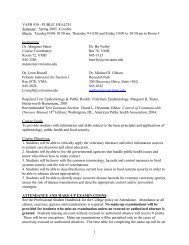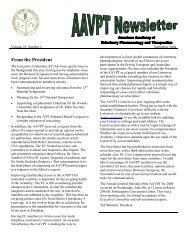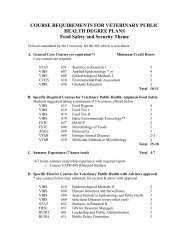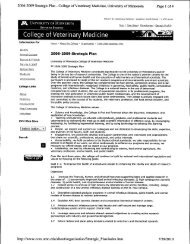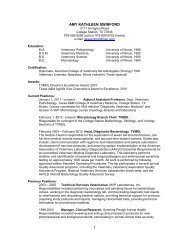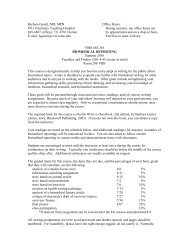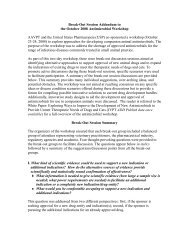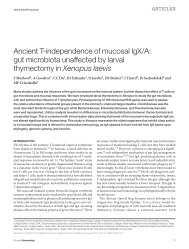Disaster - College of Veterinary Medicine - Texas A&M University
Disaster - College of Veterinary Medicine - Texas A&M University
Disaster - College of Veterinary Medicine - Texas A&M University
You also want an ePaper? Increase the reach of your titles
YUMPU automatically turns print PDFs into web optimized ePapers that Google loves.
22 • CVM Today • Summer 2010<br />
Waiting was unacceptable for the <strong>Texas</strong> A&M team. In response to Brazos<br />
County’s designation as an evacuation hub for future hurricane threats. and eager<br />
to find a solution where experts in animal welfare could respond in the event<br />
<strong>of</strong> a disaster, talks were initiated between the Emergency Response staff <strong>of</strong> Brazos<br />
County and faculty from the CVM.<br />
“We wanted to learn more about the direction that emergency response efforts<br />
were going to take in the future,” said Dr. Wesley Bissett, clinical pr<strong>of</strong>essor in the<br />
large animal clinical sciences department, “and if there was a role we could play.<br />
As the only veterinary medical college in the State <strong>of</strong> <strong>Texas</strong>, we felt we had expertise<br />
and facilities that could provide much needed support in future response<br />
efforts.”<br />
Soon after talks began with Brazos County, CVM <strong>of</strong>ficials began working on<br />
developing an agreement with the <strong>Texas</strong> Animal Health Commission (TAHC),<br />
the lead agency for animal health issues in times <strong>of</strong> emergencies. By partnering<br />
with the TAHC, the CVM could support the TAHC mission by projecting the<br />
CVM’s capabilities around the state.<br />
“Once we had a rough agreement in place with TAHC,” added Bissett, “we went<br />
to the Executive Committee <strong>of</strong> the CVM and requested that a formalized Emergency<br />
Response Committee be established at the college level. This request was<br />
approved, and we began to identify clinicians, scientists, administrative staff, and<br />
technicians who would need to have a place on these response teams.”<br />
To respond in an emergency, the teams would need special equipment and the<br />
funds to not only purchase this equipment, but also to support the team. Funds<br />
were requested and received from the <strong>Texas</strong> Division <strong>of</strong> Emergency Management,<br />
and have immediately been used to build the necessary infrastructure for the<br />
emergency response teams.<br />
“Once we knew that we were going to be able to develop formalized teams, we<br />
began to organize under the name TAMU VET, or <strong>Texas</strong> A&M <strong>University</strong> <strong>Veterinary</strong><br />
Emergency Team,” said Bissett. “We were able to purchase some special<br />
tents, satellite equipment, portable stocks & stalls, kenneling materials, etc. so<br />
that when we are out in the field, we are able to deploy as a fully self-sustaining<br />
unit.”<br />
While responding to a disaster, the teams are able to do environmental assessments,<br />
and triage <strong>of</strong> injured animals. This process can include doing toxicity<br />
sampling <strong>of</strong> water supplies to better know what is available to stranded livestock<br />
and pets, evaluating food and nutrition needs, and developing ways to stabilize<br />
the injured animals and get them to safety and shelter.<br />
“We want to limit animal suffering,” said Bissett. “So, animal welfare will be<br />
paramount to our thinking. Our college was founded on service to the state, so<br />
being able to respond when animals in the state are in need is in our tradition <strong>of</strong><br />
service.”<br />
Not only have these teams dedicated themselves to being available to provide<br />
needed aid during a disaster, but they also are using these opportunities as a<br />
teaching tool for future veterinarians. A new elective is now <strong>of</strong>fered to third year<br />
veterinary medical students that prepares them to play a role in emergency response<br />
efforts regardless where they end up in practice. Three students also serve<br />
on the TAMU VETs at any given time.<br />
“There are many roles to fill in a time <strong>of</strong> disaster,” added Bissett. “Our students<br />
are able to see how emergency response is something that brings in faculty from<br />
the clinics in a multi-disciplinary effort. Not everyone is deployed. As a major<br />
referral hospital, the CVM also needs faculty to remain in the hospital to take<br />
care <strong>of</strong> emergent animal needs that arrive from shelters, from evacuees passing<br />
through, and from the deployed teams. There’s a role for everyone, and it takes<br />
everyone to be successful at what we do.”<br />
The TAMU VETs had the opportunity to test their roles in a recent disaster<br />
preparation exercise held in April with renowned disaster response team, <strong>Texas</strong><br />
Task Force-1 (TTF-1). The scenario was an explosion in an urban area, and TTF-1<br />
Preparing to respond to disasters and emergencies requires special equipment as well<br />
as mobile units in which to set up on-site operations. Photos to the left show<br />
satellite equipment, a trailer, and tents that will be used to establish headquarters for<br />
the TAMU VET in disaster areas, as well as members <strong>of</strong> the team practicing set up.<br />
Photos by Larry Wadsworth.<br />
Photos on the opposite page show Danene Burtel, Dr. Heather Nevill, and Dr. Erica<br />
Miller, members <strong>of</strong> the Louisiana State Wildlife Response Team, cleansing a pelican <strong>of</strong><br />
oil at the Clean Gulf Associates Mobile Wildlife Rehabilitation Station on Ft. Jackson in<br />
Plaquemines Parish, La., May 15, 2010. Photo credits: U.S. Navy/Justin Stumberg.


